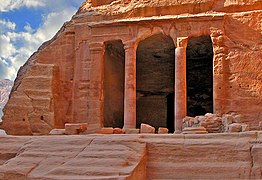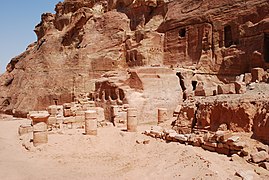Pétra
| Petra Mal:Script/Nabataean | |
|---|---|
| Mal:Image frame Dari kiri atas ke kanan: Makam Urn, teater en-Nejr, Al-Khazneh (Perbendaharaan), kuil Qasr al-Bint dan pemandangan jejak Ad Deir (Biara). | |
| Letak | Kegubernuran Ma'an, Yordania |
| Koordinat | 30°19′43″N 35°26′31″E / 30.32861°N 35.44194°EKoordinat: 30°19′43″N 35°26′31″E / 30.32861°N 35.44194°E |
| Jimbar | 264 km2 (102 sq mi)[1] |
| Ketinggian | 810 m (2,657 ft) |
| Kawangun | Mungkin pada awal abad ke-5 SM[2] |
| Pengunjung | 1,135,300 (tahun 2019) |
| Badan pengelola | Otoritas Wilayah Petra |
| Situs web | www |
Lokasi Petra Mal:Script/Nabataean di Yordania | |
 | |
| Kritéria | Kultural: i, iii, iv |
| Pustaka | 326 |
| Prasasti | 1985 (sési ka-9) |
Petra (Arab: البتراء, Al-Batrāʾ; Yunani Kuno: Πέτρα) inggih punika silih tunggil kota lelintihan miwah arkéologikal ring kelod Yordania.
Kota puniki magenah ring in a basin saking gunung punika ngembak saking Segara Mati nuju Teluk Aqaba.[3]
Galéri[uah | uah wit]
-
Siq, sinar cahaya
-
Tampilan jarak dekat Ad Deir
-
Makam Obelisk
-
Gerbang Hadrian juga dikenal sebagai Gerbang Temenos
-
Kuil Taman
-
Triklinium Berwarna
-
Makam Prajurit Romawi
-
Makam Guci
-
Kuburan batu
-
Jalur Biara Petra
-
Jalan Fasad
-
Kompleks Kolam dan Taman Petra
-
Tebing dekat Petra, Pemandangan Wadi Arabah
Pustaka[uah | uah wit]
Cutetan
- ↑ "Management of Petra". Petra National Trust. Kaarsipin saking versi asli tanggal 19 April 2015. Kaaksés 14 April 2015.
- ↑ Browning, Iain (1973, 1982), Petra, Chatto & Windus, London, p. 15, ISBN 0-7011-2622-1
- ↑ Glueck, Nelson 1959. Rivers in the desert: a history of the Negev. New York: Farrar, Straus & Cudahy/London: Weidenfeld & Nicolson
Bibliografi
- Bedal, Leigh-Ann (2004). The Petra Pool-Complex: A Hellenistic Paradeisos in the Nabataean Capital. Piscataway, New Jersey: Gorgias Press. ISBN 978-1-59333-120-7.
- Brown University. "The Petra Great Temple; History" Diakses pada 19 April 2013.
- Glueck, Nelson (1959). Rivers in the Desert: A History of the Negev. New York: Farrar, Straus & Cudahy/London: Weidenfeld & Nicolson
- Harty, Rosemary. "The Bedouin Tribes of Petra Photographs: 1986–2003". Kaaksés 17 Juli 2008.
- Hill, John E. (2004). The Peoples of the West from the Weilue 魏略 by Yu Huan 魚豢 : A Third Century Chinese Account Composed between 239 and 265 CE.
Draft annotated English translation where Petra is referred to as the Kingdom of Sifu.
- McKenzie, Judith (1990). The Architecture of Petra. (Oxford University Press)
- Mouton, Michael and Schmid, Stephen G. (2013) "Men on the Rocks: The Formation of Nabataean Petra"
- Paradise, T. R. (2011). "Architecture and Deterioration in Petra: Issues, trends and warnings" in Archaeological Heritage at Petra: Drive to Development or Destruction?" (Doug Comer, editor), ICOMOS-ICAHM Publications through Springer-Verlag NYC: 87–119.
- Paradise, T. R. (2005). "Weathering of sandstone architecture in Petra, Jordan: influences and rates" in GSA Special Paper 390: Stone Decay in the Architectural Environment: 39–49.
- Paradise, T. R. and Angel, C. C. (2015). Nabataean Architecture and the Sun: A landmark discovery using GIS in Petra, Jordan[permanent dead link]. ArcUser Journal, Winter 2015: 16-19pp.
- Reid, Sara Karz (2006). The Small Temple. Piscataway, New Jersey: Gorgias Press. ISBN 978-1-59333-339-3.
Reid explores the nature of the small temple at Petra and concludes it is from the Roman era.
- UNESCO World Heritage Centre. "Petra" Diakses pada 19 April 2013.
Pranala jaba[uah | uah wit]
| Wikivoyage madué panduan wisata Pétra. |
- Petra Travel Pplanning information
- Petra Jordan
- Petra Archaeological Park
- Video overview of Petra
- "Petra In The Early 1800s", YouTube
- University of Arkansas Petra Project Archived 2017-03-28 at the Wayback Machine. Retrieved 27 March 2017.
- Open Context, "Petra Great Temple Excavations (Archaeological Data)", Open Context publication of archaeological data from the 1993–2006 Brown University excavations at the Great Temple of Petra, Jordan
- Petra iconicarchive, photo gallery
- Petra History and Photo Gallery, history with maps. Retrieved 27 March 2017.
- Parker, S., R. Talbert, T. Elliott, S. Gillies, S. Gillies, J. Becker. "Places: 697725 (Petra)", Pleiades. Retrieved 27 March 2017.
- Pictures of Petra
- NEW MUSEUM OF PETRA
- Almost 800 pictures with captions, some panoramas
- Jordanian Ministry of Tourism and Antiquities
- Special Issue on Petra and Nabatean Culture Archived 2022-12-02 at the Wayback Machine, Jordan Journal for History and Archaeology, 2020.
- Photos of Petra at the American Center of Research
Kategori:
- Koordinat ring Wikidata
- Infobox mapframe sane nenten madue OSM relation ID ring Wikidata
- All articles with dead external links
- Articles with dead external links from June 2023
- Suratan sareng parameter tanggal ten valid ring mal
- Articles with permanently dead external links
- Suratan Wikipédia sareng penanda BNE
- Kaca sareng kategori pengawasan otoritas belum dibuat
- Suratan Wikipédia sareng penanda FAST
- Kota Romawi
- Situs arkeologi
- Yordania
- Situs Warisan Dunia
- Kota di Jalur Sutra
- Kota kuno
- Kaca antuk peta














